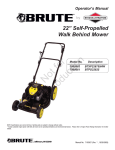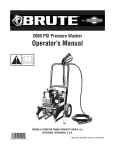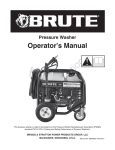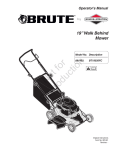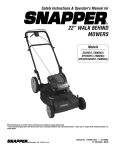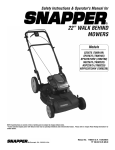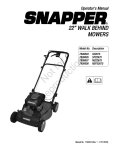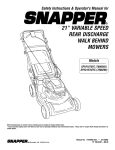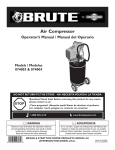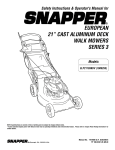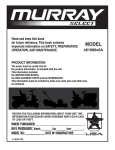Download Briggs & Stratton Brute Operator`s manual
Transcript
Safety Instructions & Operator's Manual for the 22” Self-Propelled Walk Behind Mower Models BTP2265HW (7800267) NOTE: Specifications are correct at time of printing and are subject to change without notice. * Actual sustained engine power will likely be lower due to operating limitations and environmental factors. Please refer to ‘Engine Power Rating Information’ for further details. Jefferson, WI 53549 Manual No. 7101724 (I.R. 10/23/2007) TP 100-5296-IR-WB-J Thank You for purchasing this quality-built Brute product. We’re pleased that you placed your confidence in the Brute brand. When operated and maintained according to the instructions in this manual, your Brute product will provide many years of dependable service. This manual contains safety information to make you aware of the hazards and risks associated with the machine and how to avoid them. This machine is designed and intended only for finish cutting of established lawns and is not intended for any other purpose. It is important that you read and understand these instructions thoroughly before attempting to start or operate this equipment. Save these instructions for future reference. PRODUCT REGISTRATION IMPORTANT: KEEP THIS INFORMATION FOR YOUR PERSONAL RECORDS (Complete the following information on your Brute purchase) Date of Purchase__________________________________________________________________ Retailer_________________________________________________________________________ Retailer's Phone Number___________________________________________________________ Equipment Model Number______________________________________________________________ Serial Number ______________________________________________________________ Engine Model_________________________Type__________________Trim___________________ It is very important that you register your purchase to ensure warranty coverage. Please mail your product registration card to: Brute Power Briggs & Stratton Power Products Group, LLC 900 N. Parkway Jefferson, WI 53549 Or you may register online at www.brutepower.com. You can contact us at our website, or if you would like to speak with a Customer Service Representative, call us at the Brute Customer Relations Center. For faster service please have your Serial Number and Model Number available. Brute is a trademark of Briggs & Stratton Power Products Group, LLC Jefferson, WI, USA. Briggs & Stratton Yard Power Products Group Copyright © 2007, Briggs & Stratton Corporation Milwaukee, WI, USA. All Rights Reserved. Operator Safety Table of Contents Operator Safety . . . . . . . . . . . . . . . . . . . . . . . . . . . . . . . . . . . . . . . . . . . . . . . .2 Important Operator Safety Information . . . . . . . . . . . . . . . . . . . . . . . . . . . . . . . . . . .2 Features and Controls Features and Controls . . . . . . . . . . . . . . . . . . . . . . . . . . . . . . . . . . . . . . . . . . .4 Operation Operation . . . . . . . . . . . . . . . . . . . . . . . . . . . . . . . . . . . . . . . . . . . . . . . . . . . .5 Adjusting the Handle Height . . . . . . . . . . . . . . . . . . . . . . . . . . . . . . . . . . . . . . . . . . .5 Grass Bag . . . . . . . . . . . . . . . . . . . . . . . . . . . . . . . . . . . . . . . . . . . . . . . . . . . . . . . . .6 Side Discharge Deflector . . . . . . . . . . . . . . . . . . . . . . . . . . . . . . . . . . . . . . . . . . . . . .8 Mulching Tips . . . . . . . . . . . . . . . . . . . . . . . . . . . . . . . . . . . . . . . . . . . . . . . . . . . . . .8 How to Prepare the Engine . . . . . . . . . . . . . . . . . . . . . . . . . . . . . . . . . . . . . . . . . . . .9 Pre-Start Checklist . . . . . . . . . . . . . . . . . . . . . . . . . . . . . . . . . . . . . . . . . . . . . . . . . .9 Engine Stop Lever . . . . . . . . . . . . . . . . . . . . . . . . . . . . . . . . . . . . . . . . . . . . . . . . . .10 Front Wheel Drive System . . . . . . . . . . . . . . . . . . . . . . . . . . . . . . . . . . . . . . . . . . .10 Stopping the Engine . . . . . . . . . . . . . . . . . . . . . . . . . . . . . . . . . . . . . . . . . . . . . . . .10 Starting the Engine . . . . . . . . . . . . . . . . . . . . . . . . . . . . . . . . . . . . . . . . . . . . . . . . .11 Rules for Safe and Effective Operation . . . . . . . . . . . . . . . . . . . . . . . . . . . . . . . . . .11 Maintenance Maintenance . . . . . . . . . . . . . . . . . . . . . . . . . . . . . . . . . . . . . . . . . . . . . . . . .12 Engine Maintenance . . . . . . . . . . . . . . . . . . . . . . . . . . . . . . . . . . . . . . . . . . . . . . . .12 Engine Tipping . . . . . . . . . . . . . . . . . . . . . . . . . . . . . . . . . . . . . . . . . . . . . . . . . . . .12 Cleaning the Mower Housing . . . . . . . . . . . . . . . . . . . . . . . . . . . . . . . . . . . . . . . . .12 Lubrication . . . . . . . . . . . . . . . . . . . . . . . . . . . . . . . . . . . . . . . . . . . . . . . . . . . . . . .12 Adjusting the Height of Cut . . . . . . . . . . . . . . . . . . . . . . . . . . . . . . . . . . . . . . . . . . .12 Removing the Drive Belt . . . . . . . . . . . . . . . . . . . . . . . . . . . . . . . . . . . . . . . . . . . . .13 Adjusting the Drive Cable . . . . . . . . . . . . . . . . . . . . . . . . . . . . . . . . . . . . . . . . . . . .14 Blade Service . . . . . . . . . . . . . . . . . . . . . . . . . . . . . . . . . . . . . . . . . . . . . . . . . . . . .15 Removing the Blade . . . . . . . . . . . . . . . . . . . . . . . . . . . . . . . . . . . . . . . . . . . . .15 Sharpening the Blade . . . . . . . . . . . . . . . . . . . . . . . . . . . . . . . . . . . . . . . . . . . .15 Checking the Level of Cut . . . . . . . . . . . . . . . . . . . . . . . . . . . . . . . . . . . . . . . . .15 Preparing the Mower for Storage . . . . . . . . . . . . . . . . . . . . . . . . . . . . . . . . . . . . . .16 Troubleshooting Troubleshooting . . . . . . . . . . . . . . . . . . . . . . . . . . . . . . . . . . . . . . . . . . . . . . .17 Warranty . . . . . . . . . . . . . . . . . . . . . . . . . . . . . . . . . . . . . . . . . . . . . . . . . . . .18 WARNING ! Battery posts, terminals and related accessories contain lead and lead compounds, chemicals known to the State of California to cause cancer and birth defects or other reproductive harm. Wash hands after handling. ! WARNING ! Engine exhaust, some of its constituents, and certain vehicle components contain or emit chemicals known to the State of California to cause cancer or other reproductive harm. 1 Warranties ! Operator Safety ! Important Operator Safety Instructions WARNING: This powerful cutting machine is capable of amputating hands and feet and can throw objects that can cause injury and damage! Failure to comply with the following SAFETY instructions could result in serious injury or death to the operator or other persons. The owner of the machine must understand these instructions and must allow only persons who understand these instructions to operate machine. Each person operating the machine must be of sound mind and body and must not be under the influence of any substance, which might impair vision, dexterity or judgment. If you have any questions pertaining to your machine which your dealer cannot answer to your satisfaction, call the Customer Service Department. Phone: (1-800-743-4115). Protection for Children Tragic accidents can occur if the operator is not alert to the presence of children. Children are often attracted to the machine and the mowing activity. Never assume that children will remain where you last saw them. 1. KEEP children out of the mowing area and under the watchful care of a responsible adult other than the operator. 2. DO NOT allow children in yard when machine is operated and turn machine OFF if anyone enters the area. 3. DO NOT allow pre-teenage children to operate machine. 4. ALLOW only responsible adults & teenagers with mature judgment under close adult supervision to operate machine. 5. DO NOT pull mower backwards unless absolutely necessary. LOOK and SEE behind and down for children, pets and hazards before and while backing. 6. USE EXTRA CARE when approaching blind corners, shrubs, trees, or other objects that may obscure vision. Slope Operation 1. Slopes are a major factor related to slip and fall accidents, which can result in severe injury. All slopes require extra caution. If you feel uneasy on a slope, DO NOT mow it. 2. Mow across slopes, never up-and-down. Exercise extreme CAUTION when changing directions on slopes. DO NOT mow steep slopes or other areas where stability or traction is in doubt. Refer to the Slope Guide at the end of this manual. 3. Use extra care with grass catchers or other attachments; these affect the handling and the stability of the machine. ! Preparation (Continued From Previous Column) 4. Handle fuel with extra care. Fuels are flammable and vapors are explosive. Use only an approved fuel container. DO NOT remove fuel cap or add fuel with engine running. Add fuel outdoors only with engine stopped and cool. Clean spilled fuel and oil from machine. DO NOT smoke. 5. Check the area to be mowed and remove all objects such as toys, wire, rocks, limbs and other objects that could cause injury if thrown by blade or interfere with mowing. Also note the location of holes, stumps, and other possible hazards. 6. Keep people and pets out of the mowing area. Immediately, STOP Blade, Stop engine and Stop mower if anyone enters the area. 7. Check shields, deflectors, switches, blade controls and other safety devices frequently for proper operation and location. 8. Make sure all safety decals are clearly legible. Replace if damaged. 9. Protect yourself when mowing and wear safety glasses, a dust mask, long pants, and substantial footwear. DO NOT mow barefooted or with sandals. 10. Know how to STOP blade and engine quickly in preparation for emergencies. 11. Use extra care when loading or unloading the machine into a trailer or truck. 12. Check grass catcher components frequently for signs of wear or deterioration and replace as needed to prevent injury from thrown objects going through weak or torn spots. Preparation 1. Read, understand, and follow instructions and warnings in this manual and on the mower, engine and attachments. Know the controls and the proper use of the mower before starting. 2. Only mature, responsible persons shall operate the machine and only after proper instruction. 3. Data indicates that operators age 60 and above, are involved in a large percentage of mower-related injuries. These operators should evaluate their ability to operate the mower safely enough to protect themselves and others from serious injury. 2 Safe Handling of Gasoline To avoid personal injury or property damage, use extreme care in handling gasoline. Gasoline is extremely flammable and the vapors are explosive. 1. Extinguish all cigarettes, cigars, pipes and other sources of ignition. 2. Use only an approved fuel container. 3. DO NOT remove fuel cap or add fuel with the engine running. Allow the engine to cool before refueling. 4. DO NOT refuel the machine indoors. 5. DO NOT store the machine or fuel container inside where there is an open flame, spark or pilot light such as on a water heater or other appliances. www.brutepower.com ! Important Operator Safety Instructions (Continued) 6. DO NOT fill fuel containers inside a vehicle or on a truck or trailer bed with a plastic liner. Always place the containers on the ground away from the vehicle before filling. 7. Remove gas-powered equipment from the vehicle or trailer and refuel it on the ground. If this is not possible, then refuel equipment using a portable container, rather than a gasoline dispenser nozzle. 8. DO NOT start gas powered equipment in enclosed vehicles or trailers. 9. Keep the nozzle in contact with the rim of the fuel tank or container opening at all times until fueling is complete. DO NOT use a nozzle lock-open device 10. If fuel is spilled on clothing, change clothing immediately. 11. DO NOT overfill a fuel tank. Replace fuel cap and tighten securely. Operation 1. DO NOT put hands or feet near or under rotating parts. Keep clear of discharge area while engine is running. 2. STOP engine when crossing gravel drives, walks, or roads, and under any conditions where thrown objects might be a hazard. 3. Mow only in daylight or good artificial light. 4. DO NOT operate mower while under the influence of alcohol or drugs. 5. After striking a foreign object or if mower vibrates abnormally, STOP the engine, disconnect and secure spark plug wire. Inspect the mower for any damage and repair the damage before starting. 6. DO NOT mow near drop offs, ditches or embankments. Operator could lose footing or balance. 7. STAY ALERT for holes and other hidden hazards. Tall grass can hide obstacles. Keep away from ditches, washouts, culverts, fences and protruding objects. 8. DO NOT mow on wet grass. Always be sure of your footing. Keep a firm hold on the handle and walk, never run. Slipping could cause injury. 9. ALWAYS stay behind handle when engine (motor) is running. 10. DO NOT leave the machine with the engine running. STOP BLADE and STOP ENGINE before leaving the operators position for any reason. 11. Before cleaning, repairing or inspecting make certain engine, blade and all moving parts have STOPPED. Disconnect and secure spark plug wire away from plug to prevent accidental starting. 12. STOP engine and wait until the blade comes to complete STOP before removing grass bag and/or clearing grass. Operation (Continued From Previous Column) 13. DO NOT operate mower without the entire grass catcher, rear guard or other safety devices in place and working. DO NOT point discharge at people, passing cars, windows or doors. 14. DO NOT discharge material against a wall or obstruction. Material may ricochet back towards the operator. 15. Slow down before turning. 16. Watch out for traffic when near or crossing roadways. 17. DO NOT operate engine in enclosed areas. Engine exhaust gases contain carbon monoxide, a deadly poison. 18. Only use accessories approved by the manufacturer. See manufacturer’s instructions for proper operation and installation of accessories. Maintenance and Storage 1. DO NOT store mower or fuel container inside where fumes may reach an open flame, spark or pilot light such as in a water heater, furnace, clothes dryer or other gas appliance. Allow engine to cool before storing machine in an enclosure. Store fuel container out of reach of children in a well ventilated, unoccupied building. 2. Keep mower and engine free of grass, leaves or excess grease to reduce fire hazard and engine overheating. 3. When draining fuel tank, drain fuel into an approved container outdoors and away from open flame. 4. Keep all bolts, especially blade bolts, nuts and screws properly tight. Check that all cotter pins are in proper position. 5. Always provide adequate ventilation when running engine. Engine exhaust gases contain carbon monoxide, a deadly poison. 6. Service engine and make adjustments only when engine is stopped. Remove spark plug wire from spark plug and secure wire away from spark plug to prevent accidental starting. 7. DO NOT change engine governor speed settings or overspeed engine. 8. Check grass bag assembly frequently for wear or deterioration to avoid thrown objects and exposure to moving parts. Replace with new bag if loose seams or tears are evident. Replace slider or bag adapter if broken or cracked. 9. Mower blades are sharp and can cut. Wrap the blades or wear heavy leather gloves and use CAUTION when handling them. 10. DO NOT test for spark by grounding spark plug next to spark plug hole; spark plug could ignite gas exiting engine. 11. Have machine serviced by an authorized BRUTE dealer at least once a year and have the dealer install any new safety devices. 12. Use only genuine BRUTE replacement parts to assure that original standards are maintained. 3 Operator Safety Safe Handling of Gasoline (Continued From Previous Page) ! Features and Controls IMPORTANT The figures and illustrations in this manual are provided for reference only and may differ from your specific model. Contact your dealer if you have questions. Features and Controls F H G B A D C E Features and Controls A. B. C. D. E. 4 Oil Fill Cap and Dipstick Fuel Filler Cap Mulcher Cover Rear Height Adjuster Arm (2) Front Height Adjuster Arm (2) F. G. H. Engine Stop Lever Recoil Start Grip Drive Lever www.brutepower.com Operation Adjusting the Handle Height 1. Remove the wingnuts (A, Figure 1), washers (not shown), and bolts (B) from the right and left handle brackets (C). A B Note: Do not remove the lower set of handle hardware (D). C D Figure 1: Removing the handle adjustment hardware A Operation 2. Adjust the handle to a higher or lower height adjustment hole (A, Figure 2). 3. Reinstall the bolts, washers and wingnuts removed in Step 1. Figure 2: Height adjustment holes (Components removed for clarity) 5 Operation (Continued) Assembling the Grass Bag B Note: On some models, the side mounted discharge deflector is temporarily attached (for shipping purposes) to the rear of the mower. Before assembly of the grass bag, remove the side mounted discharge deflector. 1. Slide the frame assembly (A, Figure 3) into the ends of the support tube (B). Make sure the frame assembly is fully inserted into the support tube. A Operation Figure 3: Installing the frame assembly 2. Make sure the handle (A, Figure 4) is on the outside of the grass bag. A C 3. First, attach the clips (B, Figure 4) to the side of the frame assembly (C). Next, attach the clips to the top and bottom of the frame assembly. B Figure 4: Installing the bag clips 4. Close the elastic top cover (A, Figure 5). When operating the mower with the grass bag, the elastic top cover must be in the closed operating position. A Figure 5: Closing the elastic top cover 6 www.brutepower.com Operation (Continued) Mounting the Grass Bag 1. To mount the grass bag on the mower, raise the rear door (A, Figure 6). Holding the grass bag by the handle (B), mount the hooks (C) on either end of the grass bag frame assembly onto the rear door pivot rod (D). Lower the grass bag against the rear of the mower. Lower the rear door. C D Important: Make sure both grass bag hooks are mounted on the pivot rod. WARNING: Do not use the grass bag unless the cover is closed. B Operation WARNING: Check the condition of the grass bag for wear or deterioration. If worn or damaged, replace the parts only with approved factory replacement parts. A Figure 6: Mounting the grass bag Emptying the Grass Bag WARNING: Before you remove the grass bag, stop the engine. Before you remove any grass from the mower housing, disconnect the wire from the spark plug. 1. Raise the rear door to a vertical position. 2. Hold the handle of the grass bag and lift the frame assembly. Continue to lift the frame assembly until the hooks are no longer mounted on the pivot rod. Remove the grass bag. 3. Open the top cover (A, Figure 7). Empty the grass from the grass bag. 4. To mount the grass bag on the mower, see “How To Mount The Grass Bag”. A Figure 7: Emptying the grass bag 7 Operation (Continued) Attaching the Side Mounted Discharge Deflector WARNING: To prevent the engine from starting, disconnect the wire from the spark plug. For shipping purposes, the side deflector was not installed. Locate the side deflector and install as follows. 1. Raise the mulcher cover (A, Figure 8). 2. Slide the two tabs (B) on the side deflector (C) under the pivot pin. 3. Lower the side deflector. Make sure the locking tab (A, Figure 9) goes through the slot in the side deflector. 4. Lower the mulcher cover (A, Figure 10). 5. Attach the wire to the spark plug. Operation A C A Figure 9: Side discharge deflector locking tabs A B Figure 8: Installing the side discharge deflector Figure 10: Releasing the mulcher cover Mulching Tips Mulching finely cuts the grass so that the grass can be easily recycled. Because the nutrients are returned to the soil, the lawn will need less fertilizer. To correctly mulch the lawn, follow the tips below. The grass must be dry. If the grass is wet, it will be difficult to cut and cause heavy clumps of grass. The grass must not be too tall. The maximum height to effectively cut is 4 1/2 inches. Set the height adjusters so that only the top third of the grass is cut. If the grass is more than 4 1/2 inches high, two mowings will be necessary. For the first mowing, set the height adjusters in the highest position. Then, lower the height adjusters for the second mowing. 8 Keep a sharp edge on the blade. A blade that is not sharp will cause the ends of the grass to become brown. Clean the underside of the mower housing. Grass and other debris can keep the mower from working correctly. If the quality of cut is marginal, try the following: Set the height adjusters at a higher cutting height. Cut the grass more frequently. Operate the mower at a slower ground speed. Overlap the cutting swaths instead of cutting a full swath with each pass. Mow across the marginal areas a second time. www.brutepower.com Operation (Continued) Preparing the Engine ENGINE DOES NOT CONTAIN OIL OR GASOLINE Fill the engine with the proper amount of oil. See the engine manufacturer’s instructions for the type of gasoline and oil to use. Before you use the unit, read the information on safety, operation, maintenance, and storage. WARNING: Follow the engine manufacturer’s instructions for the type of gasoline and oil to use. Always use a safety gasoline container. Do not smoke when adding gasoline to the engine. When inside an enclosure, do not fill with gasoline. Before you add gasoline, stop the engine. Let the engine cool for several minutes. IMPORTANT: This unit is equipped with an internal combustion engine and must not be used on or near any unimproved forest-covered, brush-covered or grass-covered and unless the engine’s exhaust system is equipped with a spark arrester meeting applicable local or state laws (if any). If a spark arrester is used, it must be maintained in effective working order by the operator. In the State of California the above is required by law (Section 4442 of the California Public Resources Code). Other states may have similar laws. Federal laws apply on federal lands. See an Authorized Service Center for a spark arrester for the muffler. Note: Actual sustained engine power will likely be lower due to operating limitations and environmental factors. Operation Note: The operation of a new engine will sometimes result in a slight amount of smoke. This smoke is caused by paint or oil on or around the muffler. This is normal and only expected during initial operation. Pre-Start Checklist Before you use the mower, check the assembly of the wheels, the handle, and the controls. Make sure all the fasteners are tight. Make sure the throttle control (if equipped) and the engine stop lever work correctly. If the mower is equipped with height adjusters, make sure the height adjusters function properly. Before starting the engine, make sure each height adjuster is set at the desired height. See “Adjusting The Height Of Cut” in the Maintenance sections. 9 Operation (Continued) Engine Stop Lever Release the engine stop lever (A, Figure 11) and the engine and the blade will automatically stop. To run the engine, hold the engine stop lever in the Operating position (B). WARNING: For safe operation, the drive system must immediately disengage when the drive lever is released. If the drive system does not disengage correctly, do not operate the mower until the drive system is adjusted or repaired by an authorized service center. Before you start the engine, operate the engine stop lever several times. Make sure the cable moves easily. B A B Operation A Figure 11: Operating the engine stop lever Front Wheel Drive System C The mower has a front wheel drive system. Operate the drive system as follows. 1. Hold the engine stop lever in the Operating Position (A, Figure 12). 2. Push the drive lever (B) completely forward (C). When the drive lever clicks, release the drive lever. The drive system is now engaged. Note: To stop the engine, release the engine stop lever. 3. To disengage the drive system and stop the engine, completely release the engine stop lever. 4. To disengage only the drive system, release the engine stop lever approximately two inches. The drive system will disengage but the engine will continue to run. Note: When the drive system is disengaged on a new unit, it is possible for the front wheels to rotate if lifted off the ground. This is normal and will stop after one or two hours of operation. 10 Figure 12: Operating the front wheel drive system Stopping the Engine To stop the engine, release the engine stop lever. Disconnect the wire from the spark plug to prevent the engine from starting. If the engine will not stop, hold a screwdriver against the spark plug and against the engine cooling fins. The spark will go to ground and the engine will stop. Before you start the engine, check the engine stop cable. Make sure the engine stop cable is assembled correctly. Before you operate the unit, replace a bent or damaged engine stop cable. www.brutepower.com Operation (Continued) Starting the Engine WARNING: The blade will rotate when the engine runs. IMPORTANT: Before you start the engine, operate the engine stop lever several times. Make sure the engine stop cable moves freely. 5. Stand behind the mower. Use one hand to hold the engine stop lever in the operating position (A, Figure 13). Use the other hand to hold the recoil-start grip (B). 6. Make sure the recoil-start rope is not obstructed or caught between the upper and lower handles. Rapidly pull the recoil-start grip. Slowly return the recoil-start grip. 7. If the engine does not start in 5 or 6 tries, refer to the “Troubleshooting” section of this manual. Note: The engine design does not include a throttle control or an engine speed adjustment. The engine is set at the best speed for cutting grass, bagging grass, and for extended engine life. A 1. Check the oil. 2. Fill the fuel tank with regular unleaded gasoline. Make sure the gasoline is clean. Leaded gasoline will increase deposits and shorten the life of the valves. Note: Do not use gasohol or methanol. Do not use premium unleaded gasoline. 3. Make sure the spark plug wire is connected to the spark plug. 4. Make sure the drive lever is in the disengaged position (B, Figure 14). WARNING: To prevent an accident, make sure the drive lever is in the DISENGAGED position. When the drive lever is in the ENGAGED position, do not start the engine. Operation WARNING: Always use a safety gasoline container. Do not smoke when adding gasoline to the fuel tank. When inside an enclosure, do not add gasoline. Before you add gasoline, stop the engine and let the engine cool for several minutes. B Figure 13: Starting the engine Rules for Safe and Effective Operation Refer to the ‘Operator Safety’ section of this manual for important rules concerning safe and effective mower operation. 11 Maintenance Engine Maintenance Use the following maintenance section to keep your unit in good operating condition. All the maintenance information for the engine is in the “Engine Instruction Book”. Before you start the engine, read this book. Hard starting. Engine smoking. Spark plug fouling. Oil or gas saturation of the air filter. WARNING: Before you make an inspection, adjustment (except carburetor), or repair, stop the engine and disconnect the wire from the spark plug. Engine Tipping When you service the engine, inspect the blade, or clean the underside of the mower housing; make sure to always tip the engine with the spark plug up (Figure 14). Transporting or tipping the engine with the spark plug down will cause: Maintenance Cleaning the Mower Housing Figure 14: No forward engine tipping Adjusting the Height of Cut WARNING: The blade will rotate when the engine runs. Before you clean the mower housing, stop the engine and disconnect the wire from the spark plug. WARNING: The blade will rotate when the engine runs. Before you change the height of cut, stop the engine and disconnect the wire from the spark plug. Grass and other debris can keep the mower from working correctly. After you mow, clean the mower housing as follows. To change the height of cut, move the position of the adjuster arm at each wheel (A, Figure 15). Make sure each adjuster arm is in the same position so that the mower will cut level. 1. Stop the engine. 2. Disconnect the wire from the spark plug. 3. Clean dirt and debris from the top and the bottom of the mower housing. Clean with soap and water. Wipe off excess water before storage. 1. Disengage the adjuster arm. 2. Move the adjuster arm to another position. A Lubrication 1. For maximum performance, lubricate the wheels and all pivot points with engine oil every 25 hours. 2. To lubricate the engine, refer to the “Engine Instruction Book”. Note: Do not lubricate the engine stop cable. Lubricants will damage the cable and prevent the cable from moving freely. Replace the cable if bent or damaged. Figure 15: Adjusting the height of cut 12 www.brutepower.com Maintenance (Continued) Removing the Drive Belt A C WARNING: Before you remove the belt, disconnect the wire from the spark plug. 1. Remove the screw that secures the belt cover (A, Figure 16). Remove the belt cover. 2. To remove the drive belt, tip the mower up. See “Engine Tipping” in the Maintenance section. 3. Loosen the belt tension bolt (A, Figure 17). 4. Remove the front of the drive belt (B) from the transmission pulley (C). 5. To remove the rear of the drive belt (A, Figure 18), slip the drive belt over the end of the blade (B). Note: Make sure you replace the drive belt only with a replacement belt from the factory. B Figure 17: Loosening the belt tension bolt A Maintenance 6. To assemble the drive belt, reverse the above steps. 7. Set the belt tension. a. Tighten the adjuster nut (A, Figure 19) until the nut touches the spacer (B). Try to turn the spacer. When the adjuster nut touches the spacer, the spacer will not turn. b. Then, loosen the adjuster nut only enough to allow the spacer to turn. The tension on the drive belt is now correct. 8. Install the belt cover. 9. Before you begin to mow, make sure the drive system will correctly disengage and that the mower will stop. If the drive system will not disengage, take the mower to an authorized service center before you operate the mower. A B Figure 18: Removing the belt B A Figure 16: Removing the belt cover Figure 19: Setting the belt tension 13 Maintenance (Continued) Note: The engine design does not include a throttle control or an engine speed adjustment. The engine is set at the best speed for cutting grass, bagging grass, and for extended engine life. Adjusting the Drive Cable WARNING: Before you adjust the drive cable, release the engine stop lever and wait for the engine to stop. 1. If the drive system is slipping, turn the cable adjuster (A, Figure 20) one turn in the direction shown. Test the drive system and check for slippage. 2. If the drive system still slips, turn the cable adjuster one more turn to shorten the cable. Again, test the drive system. 3. Repeat the adjustment and test until the drive system does not slip. 4. Before you begin to mow, make sure the drive system will correctly disengage and that the mower will stop. If the drive system will not disengage, take the mower to an authorized service center before you operate the mower. If the drive system does not engage and disengage correctly, check the handle for correct assembly. Make sure that all parts are in good condition, not broken or bent, and that all fasteners are tight. Worn parts and cable stretch will change the performance of the drive system. When you mow in high or thick grass or on hills, the drive system can slip. If the drive system is slipping, adjust as follows or take the mower to an authorized service center. Maintenance IMPORTANT: Before you start the engine, operate the engine stop lever several times. Make sure the engine stop cable moves freely. A Figure 20: Adjusting the drive cable 14 www.brutepower.com Maintenance (Continued) Blade Service WARNING: Before you inspect the blade or the blade adapter, disconnect the wire to the spark plug. If the blade hits an object, stop the engine. Disconnect the wire to the spark plug. Check the unit for damage. Frequently check the blade for wear or damage such as cracks. Frequently check the bolt that holds the blade. Keep the bolt tight. If the blade hits an object, stop the engine. Disconnect the wire to the spark plug. Check the blade adapter (A, Figure 21) for damage. Check for a bent or damaged blade, a badly worn blade, or other damage. Before you operate the unit, damaged parts must be replaced with factory replacement parts. For safety, replace the blade every two years. Keep a sharp edge on the blade. A blade that is not sharp will cause the ends of the grass to become brown. Remove the blade as follows. Removing the Blade WARNING: Before you remove the blade, disconnect the wire to the spark plug. The blade has sharp edges. When you hold the blade, use gloves or cloth material to protect your hands. WARNING: Always keep the bolt that holds the blade tight. A loose bolt or blade can cause an accident. C D A B C D B Figure 21: Removing the blade Sharpening the Blade WARNING: Vibration is the result if the blade is not correctly balanced. A blade that is damaged with cracks can break and cause an accident. 1. Sharpen the blade two times a year or every 25 hours. 2. If the blade is on the unit, do not sharpen. Remove the blade according to the instructions in “Removing the Blade”. 3. Clean the blade with a brush, soap, and water. Check the blade. Look for cracks, nicks, or other damage. Replace a blade that is badly worn, bent, or damaged with a factory replacement blade. 4. Sharpen the blade (A, Figure 22, next page) with a file (B). Make sure you keep the original beveled cutting edge. 5. Make sure the blade is balanced. Use a screwdriver (C) and hold the blade parallel to the ground (D) as shown. A blade that is balanced will stay parallel to the ground. If the blade is not balanced, the heavy end will rotate toward the ground. Sharpen the heavy end until the blade is balanced. 6. A new blade will cut better than a badly worn blade. Every two years replace the old blade with a factory replacement blade. Checking the Level of Cut Test the unit in a small area. If the height of cut is not level or if the cut grass is not discharged, the cause can be: (1) the blade is bent or damaged, (2) the blade is not sharp, (3) a worn blade, (4) or a broken blade adapter. Before you use the unit, correct the problem. 15 Maintenance 1. Drain the fuel tank. 2. Lift the side of the mower that has the muffler or spark plug. 3. Use a piece of wood to keep the blade from rotating. 4. Remove the bolt (B, Figure 21) that holds the blade with a 9/16” (14mm) wrench. 5. Check the blade (C) according to the “Blade Service” instructions. Replace a badly worn or damaged blade with a factory replacement blade. 6. Mount the blade with the curved edges toward the housing. If the blade is upside down, the blade will not cut correctly and can cause an accident. 7. Fasten the blade with the original washer (D) and bolt. Make sure the outside rim of the Belleville washer is toward the blade. 8. Tighten the bolt that holds the blade to a torque of 30 foot pounds. A Maintenance (Continued) A B C D Figure 22: Sharpening the blade Preparing the Mower for Storage Maintenance WARNING: Do not remove gasoline while inside a building, near a fire, or while you smoke. Gasoline fumes can cause an explosion or a fire. 1. Drain the fuel tank. 2. Let the engine run until it is out of gasoline. 3. Drain the oil from the warm engine. Fill the engine crankcase with new oil. 4. Remove the spark plug from the cylinder. Pour one ounce of oil into the cylinder. Slowly pull the recoil-start grip so that the oil will protect the cylinder. Install a new spark plug in the cylinder. 16 5. Clean the dirt and debris from the cylinder cooling fins and the engine housing. 6. Clean the bottom of the mower housing. 7. Make sure the grass bag is empty of grass. Grass remaining in the bag during storage will damage the bag. 8. Completely clean the mower to protect the paint. 9. Fold the handles (if desired). CAUTION: Be careful when you fold or raise the handles. Do not damage the cables. A cable that is bent will not work correctly. Before you use the unit, replace a bent or damaged cable. 10. Put the unit in a building that has good ventilation. www.brutepower.com Troubleshooting The engine will not start. 1. 2. 3. 4. Make sure the fuel tank is filled with clean gasoline. Do not use old gasoline. Make sure the wire for the spark plug is connected to the spark plug. Adjust the Carburetor. Refer to the Engine Manual. There is too much gasoline in the engine cylinder. Remove and dry the spark plug. Pull the recoil-start grip several times. Install the spark plug. Connect the wire to the spark plug. Start the engine. 5. The engine is difficult to start in heavy or high grass. Move the mower to a clean dry surface. 6. Make sure the engine stop lever is in the operating position. The engine will not stop. 1. Release the engine stop lever. 2. Check the engine stop cable. Replace the cable if bent or damaged. Engine performance is bad. 1. 2. 3. 4. 5. 6. 7. 8. 9. Check the height of cut settings. Raise the height of cut if the grass is high. Check the bottom of the blade housing. Clean the blade housing of grass and other debris. Check the wire to the spark plug. Make sure the wire is connected. Clean the engine cooling fins of grass and other debris. Check the carburetor adjustments. Refer to the Engine Manual. Check the spark plug gap. Set the spark plug gap at 0.030”. Check the amount of oil in the engine. Fill with oil if necessary. Check the engine air cleaner. Refer to the Engine Manual. The gasoline is bad. Drain and clean the fuel tank. Fill the fuel tank with clean gasoline. Excessive vibration. 1. 2. 3. 4. Remove the blade. Check the blade and balance if necessary. See the blade maintenance instructions. Check for a bent or broken blade. A damaged blade is dangerous and must be replaced. Check the blade adapter. Replace a broken blade adapter. If the vibration continues, take the mower to an Authorized Service Center. The grass will not discharge correctly. 1. Clean the bottom of the mower housing. 2. Check for a badly worn blade. Remove and sharpen the blade. For safety, replace the blade every two years with a factory replacement blade. 1. 2. 3. 4. Troubleshooting The grass is not cut even. Check the height adjustment at each wheel. The height adjustment must be the same for each wheel. Make sure the blade is sharp. Check for a bent or broken blade. A damaged blade is dangerous and must be replaced. Check for a broken blade adapter. Replace a broken blade adapter. 17 BRUTE Two Year Limited Warranty Brute warrants to the original purchaser that this unit shall be free from defects in material and workmanship under normal use and service for a period of two (2) Years from the date of purchase; however, this warranty does not cover engines, accessories (such as snow blowers, snow blades, grass baggers and plows), transmissions, batteries and Normal Wear Parts (except as noted below) or transaxles as the companies that manufacture these items furnish their own warranties and provide service through their authorized field service facilities. For additional information, see the warranties covering these particular parts. If you are uncertain whether your unit contains or is equipped with one or more of these parts, consult your dealer prior to purchase. Subject to the terms and conditions noted in this Limited Warranty, we shall, at our option, repair or replace at no cost to the original purchaser any part covered by this Limited Warranty during the applicable warranty period. In the event the battery proves defective within ninety (90) days from the date of purchase, we will replace it without charge. If the battery proves defective after (90) days but within one hundred twenty (120) days from the date of purchase, we will replace it for a charge of one half (1/2) of the retail price of the battery in effect at the time of return. Normal Wear Parts are defined as belts, blades, blade adapters, pneumatic tires, headlights and seat covers. These parts are warranted to be free from defects in material and workmanship as delivered with the product. Any claim for repair or replacement of Normal Wear Parts must be made within thirty (30) days of the date of purchase. No claims involving damage caused from material use, abuse or misuse will be honored. This Brute Two (2) Year Limited Warranty is your exclusive remedy; however, this warranty is void or does not apply to any unit that has been tampered with, altered, misused, abused or used for rental or other commercial and/or professional (non-homeowner) uses. Your warranty does not cover minor mechanical adjustments which are not due to any defect in material or workmanship. For assistance in making such adjustments, consult your Instruction Book. To make a claim under this Brute Two (2) Year Limited Warranty, return the unit (or if authorized in advance, the defective part) along with your proof of purchase to an Authorized Service Center near you. To locate the nearest Authorized Service Center, call the Central Parts Distributor for your area shown in the list provided with your unit or check the Yellow Page listings in your local telephone directory. If you return the entire unit, we will repair the unit. If we authorize the return of the defective part only, we will either replace or repair the part. In the case of a defect in a transmission or differential (as distinguished from a transaxle), the entire transmission or differential must be returned since they do not include user serviceable parts. This Brute Two (2) Year Limited Warranty gives you specific legal rights, and you may also have other rights which vary from state to state. This Limited Warranty is given in lieu of all other expressed and implied warranties including the implied warranty of merchantability and warranty of fitness for a particular purpose. If you need additional information on this written warranty or assistance in obtaining service, call or write to the address below. The model number along with the CUSTOMER CARE Center 1-800 number is on the Model Number Nameplate attached to the unit. BRUTE Warranties Briggs & Stratton Power Products Group, LLC 900 N. Parkway Jefferson, WI 53549 18 www.brutepower.com Slope Guide 19 Notes 20 www.brutepower.com Notes 21 22” Self-Propelled Walk Behind Mower Product Specifications Deck Size (in) Height of Cut (in) Transmission Type Ground Speed (mph) Engine Power (gross torque) Engine Displacement (cc) Fuel Tank Capacity (qt) 22 1.5 - 3.5 Single Speed / Gear 2.3 6.5 190 1.6 Common Service Parts Part Number Blade Control Cable Wheel Drive Cable Cutter Blade Drive Belt 7101861 721854 7100851 7101193 Engine Power Rating Information: The gross power rating for individual gas engine models is labeled in accordance with SAE (Society of Automotive Engineers) code J1940 (Small Engine Power & Torque Rating Procedure), and rating performance has been obtained and corrected in accordance with SAE J1995 (Revision 2002-05). Torque values are derived at 3060 RPM; horsepower values are derived at 3600 RPM. Actual gross engine power will be lower and is affected by, among other things, ambient operating conditions and engine-to-engine variability. Given both the wide array of products on which engines are placed and the variety of environmental issues applicable to operating the equipment, the gas engine will not develop the rated gross power when used in a given piece of power equipment (actual "on-site" or net horsepower). This difference is due to a variety of factors including, but not limited to, accessories (air cleaner, exhaust, charging, cooling, carburetor, fuel pump, etc.), application limitations, ambient operating conditions (temperature, humidity, altitude), and engine-to-engine variability. Due to manufacturing and capacity limitations, Briggs & Stratton may substitute an engine of higher rated power for this Series engine. 22 Briggs & Stratton Power Products Group, LLC 900 N. Parkway 1-800-743-4115 Jefferson, WI 53549 www.brutepower.com
























